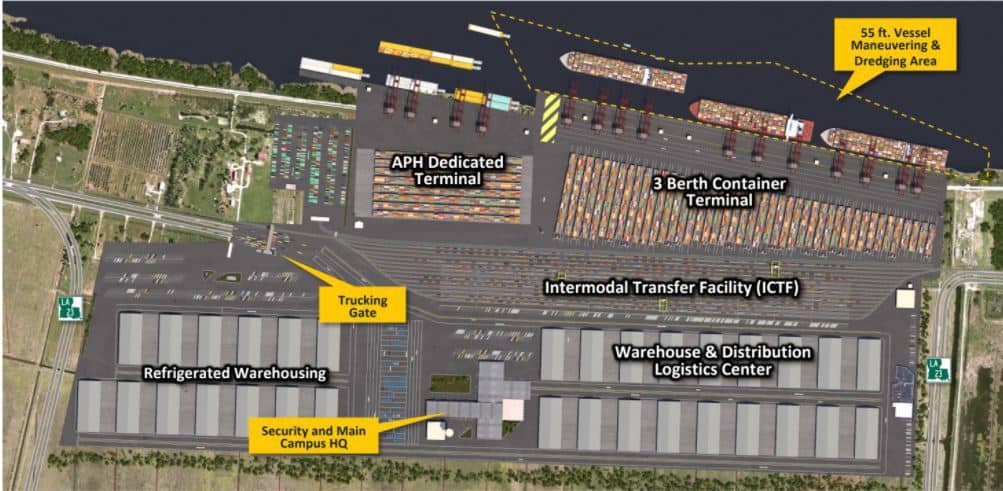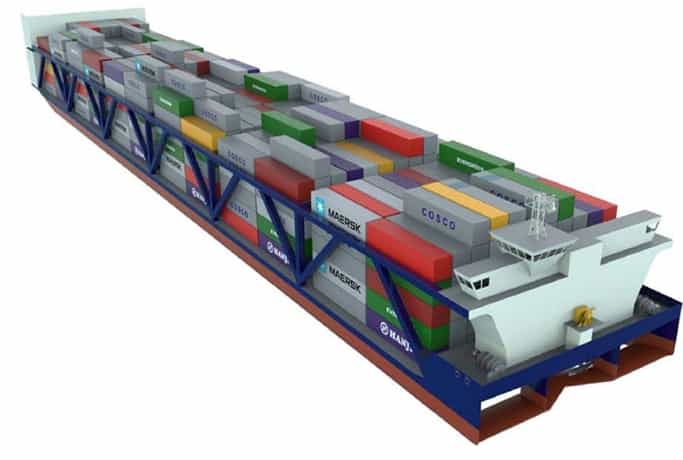American Patriot Holdings (APH) intends to make waves in the river transport industry with first-of-their-kind container-carrying vessels plying U.S. inland waterways.
The container-on-vessel (COV) service will carry more cargo than the age-old barges while reducing shippers’ costs and cutting time on the water in half, according to Sal Litrico, chief executive officer of American Patriot Container Transport LLC.
“We’re creating a new transportation system and I really emphasize the word system because it’s really a north-south trade lane from the Midwest to the lower Mississippi River that doesn’t exist today for containerized cargo,” Litrico said.
The COV service has been in the works for more than four years but is making steady progress toward reality, he said. “We are in a significant due-diligence process with very close strategic partners.”
Litrico would not name those partners, but the Plaquemines Port Harbor and Terminal District (PPHTD) has been a vocal supporter and in August announced it had signed a letter of intent to develop a multimodal, state-of-the-art container terminal at the Louisiana port to accommodate the APH vessels.

“In 10 years, there’s going to be a 10 billion-ton increase in maritime cargo,” Plaquemines Executive Director Sandy Sanders was quoted as saying in a post on the APH website. “If that cargo is going to the Gulf Coast, you need a true gateway port.”
Sanders said the Plaquemines gateway, located at the mouth of the Mississippi, will be able to accommodate a container ship with the capacity to carry 22,000 twenty-foot equivalent units (TEUs) and connect with all modes of transportation to the Midwest. He said the terminal will be like no other in the nation and give beneficial cargo owners optimal options to move their goods.
The entire project is trumpeted as green, with APH saying all its vessels will have clean fuel propulsion. PPHTD said the terminal will operate on electricity, liquefied natural gas (LNG) and compressed natural gas (CNG) and will have the capacity to bunker LNG-powered vessels.
“All existing facilities currently operating in the port jurisdiction utilize private docks and are currently all handling liquids and bulk, not containers,” the PPHTD’s Dale Benoit said. “This will be our first container terminal. Three 22,000-TEU vessels working simultaneously is the planned max capacity; 14,000 TEUs is more like the vessel size initially.”
‘Let’s do this’
The signing of the letter of intent in August kicked off a monthslong due-diligence process that is being conducted by APH, PPHTD and those unidentified partners.
“We’re looking at the whole project,” Litrico said this week. “We’re looking at the footprint at the lower Mississippi River, Plaquemines. We’re going to be looking at each port that needs to be vetted.”
The plan is to launch the COV service with four vessels — two liners each with a capacity of 2,375 TEUs and two hybrids each capable of carrying 1,700 TEUs — that will be homeported at Plaquemines. Consolidation ports are planned for St. Louis, Memphis, Tennessee, and Joliet, Illinois.
“We’re going through this due-diligence process — all of us together. We will be done in the first quarter of 2021, at which time we’ll all get to what we’re calling an FID, our final investment decision. Everybody signs on the dotted line. We move forward, we’re done, we agree, let’s do this. At that time, we’ll award our vessels to a shipyard and there will be construction started at Plaquemines, and select Midwest ports will start construction,” Litrico said.
“Our operational service date will be two years from FID,” he continued. “Another way of putting it is the first quarter of 2023. Now keep in mind this is the marine portion of it. Plaquemines will have full intermodal rail and so forth. Some of those aspects will take longer. The rail will definitely take longer at Plaquemines than it will on the marine side of it.”
Not your mother’s — or grandmother’s — river barge
Litrico promises the COV service will be like nothing before seen on Midwest rivers.
And it’s hard to miss the traditional long, low, slow-moving river barges. More than 22,000 river barges were plying American waterways in August 2018, according to Capt. James McNamara in his Maritime History Notes.
Traditional barges move more than 600 million tons of liquid and dry products through U.S. waterways annually, Sandor Toth, publisher of River Transport News, told FreightWaves CEO Craig Fuller in an October 2019 episode of “Fuller Speed Ahead.”
“Obviously our vessel is not your typical inland towboat and barge. It is purpose-built to carry containerized cargo, to get as much containerized mass as possible, and optimize logistics and efficiencies to get to the lowest cost. So it’s built to carry as much cargo as we can on a 9-foot draft,” Litrico said. “There is no kind of vessel that operates on the inland system today that’s going to have the technology and the state-of-the-art equipment that this vessel will have.”

Litrico explained that the COV service will be different.
“The barges that are being utilized today are really coal and grain barges and containers become an ancillary revenue source. They’re not really built to optimize the container world. We have a patented, purpose-built container-on-vessel to handle exactly that. Its one and only job is to move containers — critical-mass, high-volume, optimized logistics to get to the lowest cost possible for the customer. That’s what we’re really after. Our vessels also offer diversification. We can do refrigerated cargo as well. Anything that can go in a container, we’ll be able to move it,” he said.
Litrico maintained that no harbor deepening or dredging will be required to accommodate the APH vessels.
“The liner vessel is our dedicated vessel operating from Plaquemines to Memphis, Plaquemines to St. Louis,” Litrico said. “It will be a dedicated, on-time, scheduled service. It’s the biggest vessel and widest vessel. It’s 595 feet long, 134 feet wide. The only thing that vessel will encounter are very high bridges and that will be from the lower Mississippi all the way to about downtown St. Louis. Our liner vessel can carry up to 2,375 TEUs on a 9-foot draft.
“Our hybrid vessel will have all the efficiency of the liner vessel but smaller and a little bit more nimble because it will operate in the tributary rivers. Tributary rivers have lower bridges and locks and dams. The standard lock and dam throughout the Midwest is 600 feet long and 110 wide. These will be 595 by 100. Thus, they will fit through the locks. The hybrid can carry up to 1,700 TEUs,” he said.
Litrico said the APH vessels will travel “significantly faster” than a barge.
“We have this optimized bow design that basically reduces drag and we can increase our speed. Keep in mind, on the river system today you have a series of barges that are connected together by wires and then there’s a towboat. That towboat is connected by wires to the barges. You have to be very careful when you steer that vessel. You put too much rudder on it, you break those wires. We don’t have any of those issues because we have one composite unit, one big vessel, no pieces to it. A conventional towboat and barge heading upriver against the current, the speed is 4 or 5 miles an hour. Ours is 13 miles an hour — a significant competitive advantage,” he said.
With a speed more than twice that of a barge, the COV service will make a round trip between St. Louis and Plaquemines in 10 days and between Memphis and the Louisiana port in seven days, according to Litrico.
The minimal wake bow is one of two patents APH holds on the new vessels. The other is for the exoskeleton hull structure. The patented features were tested in a 28-foot-long, 6.4-foot-wide model in Germany in the fall of 2017.
“We knew that we needed to bring in a marine application that was different, that would bring some tremendous value and that will tie in all the pieces and hold its own weight in the system. Naviform is an outstanding company and they’ve designed a great vessel. Obviously, we worked together on the requirements of that vessel, and I think we’ve come up with something that’s truly unique,” Litrico said.
He didn’t want to talk price but said, “You can get coal barges for half a million bucks and then towboats can be 10 to 15 million bucks. How many of those barges do you need to complement what we’re trying to do?
“A new container-on-vessel cost is going to be appreciably higher than a conventional towboat and barge for obvious reasons. It’s totally different, more sophisticated, totally state-of-the-art equipment. That investment is more than justified by the optimization and the efficiency that the vessel will produce — without a doubt,” Litrico said.
But wait, there’s more
In addition to faster and cheaper transportation, the COV service will solve the problem of empty containers that need to be moved, according to Litrico.
“Another ancillary service will be repositioning of empty containers — i.e., out of the Chicago area. We can reposition those empty containers that were very, very expensive to do. We can do it at a very low cost, reposition them to one of our other strategic ports for distribution to our customers so they can reload it for cargo exported back out. We can commingle it with loaded cargo and reposition these containers and take advantage of it on a very timely basis.So it’s a double positive,” he said.
Another positive, according to Litrico, is that the project will be entirely privately funded.
“All of our models are based on self-support,” he said. “There’s nothing we’re looking at to subsidize the marine side of it as far as we need X amount of dollars to support or subsidize our daily cost. There could be some grants out there for some of these other Midwest ports, some environmental grants. That’s possible that they may be going and looking for that type of assistance. But that’s the exception.”
Litrico would not disclose even a rough estimate of the cost of the vessels or the container terminals.
“We are right now negotiating and talking to shipyards today, and the last thing I want to do is put a benchmark out there,” he said. “If we put a benchmark out there, I have a funny feeling we’d see that coming back in our bids. Let’s just say the efficiencies justify the capital investments. It is a significant investment but justifiable by the volume and the ability to attract the business to support it.”
Litrico would say that the vessels will be American made because of Jones Act requirements. “And we want them to be American made. We’re looking at local shipyards in the Louisiana area, the Midwest and some other locations that provide great service and quality at a reasonable price.”
Although an actual vessel does not yet exist, APH already is lining up customers.
“We are in serious negotiations with customers as we speak. Some customers are utilizing container services today. They have a need to have containers shipped worldwide and they’re looking for a transportation service that has some performance enhancements and obviously transportation savings,” Litrico said. “There is some new manufacturing that does not exist today that is very interested in what we are doing and would like to locate closely to where we are going to be operating out of so they can take advantage of our system. It’s pretty significant volumes.”
Mississippi River container on vessel service envisioned
Long Beach bridge, decade in the making, opens Monday
HMM’s 12th 24,000-TEU container ship en route to Rotterdam
Click for more American Shipper/FreightWaves stories by Senior Editor Kim Link-Wills.










